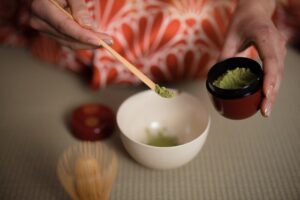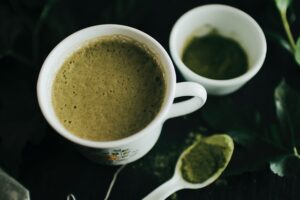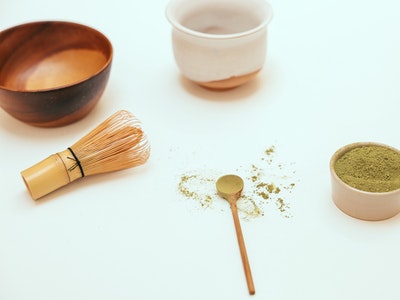Last Updated on 25/07/2021 by Miki
Table of contents
Matcha has been used by the Japanese for centuries and is making its way around the world. As a Japanese myself, matcha is a significant part of our food culture and I love anything with matcha from drinks to sweets. It has not only a unique flavour but also a vibrant colour that stands out. However, many people don’t know what matcha tastes like. Matcha is a powerful powder form of green tea that is brewed and consumed by many people globally. It’s a delicious, full-bodied tea made from the highest quality green tea leaves. Here’s everything you need to know about what matcha tastes like and how to use matcha powder.

What is Matcha?
Matcha is a traditional Japanese tea that has been made for centuries and is well-loved by the Japanese people. Traditionally, matcha is made from the highest quality green tea leaves. Like many teas, the only ingredients are water and tea leaves. Matcha is typically made with matcha green tea, which is a dark-green tea grown in Japan. Since matcha is not readily available outside of Japan, it has been a rare, luxury product. Matcha that is exported outside of Japan have been compromised and often sweetened.
How Matcha Works
Here are a few key points to understand when using matcha: Matcha is traditionally made from a variety of the very best green tea leaves. In Japan, matcha is typically made using tea leaves that are harvested when the tea leaves are between 15-20% ripe. The Japanese process of making matcha uses specific steps to prepare the powder. The leaves are cleaned and dried and then pounded until they are very fine. When the powder is ready, it is whisked with hot water to make matcha, which is like a green tea concentrate. The higher the quality of matcha, the deeper and more vibrant its flavour will be.
What does Matcha taste like?
If you’ve never tried matcha before, you may be curious about what it tastes like. Matcha can taste a little sweet or, in some cases, sour. Depending on the flavour of the matcha, it may also taste slightly bitter. Matcha is intensely green in colour and the taste of the matcha may vary slightly depending on which matcha source you use. Generally, matcha has an aroma that is often described as being grassy or slightly earthy. Matcha is a natural source of antioxidants, with one study showing that this tea could help prevent the build-up of plaque in the arteries. Furthermore, the high levels of minerals and antioxidants found in matcha help to combat oxidative stress, which is a condition that damages your body’s cells and can lead to premature aging and skin imperfections. Matcha is a great option for anyone looking for a flavorful tea to consume on a regular basis without any worry that it has any sort of unpleasant aftertaste.
This post may contain affiliate links. If you use these links to purchase something, I may earn a commission without any extra cost to you. I would appreciate it if you do so to keep this blog going!
How to Use Matcha Powder
Traditional Matcha
When making traditional matcha, the preparation process is the most important aspect. In high-quality tea ceremonies, there is a sense of harmony and balance. The preparation of the tea entails a number of steps in a specific order. There are some key points to make delicious matcha:
- First, purchase good quality, organic, matcha tea powder that should be grown in the shade for the least amount of time to bring out the freshness of the leaf. Matcha tea powder should be used as soon as possible because it gradually loses its flavour and potency. Then, measure your matcha powder. This is done by adding a teaspoon of the powder at a time. Add about 1 to 1.5 teaspoons of matcha powder to a small bowl. Shifting the powder is highly recommended for smoothness.
- Next, prepare a tea whisk to perform the whisking and frothing process. I recommend using a Japanese tea whisk. A Japanese tea whisk is known for its multi-faceted holes where the tea can be whisked and frothed. Then, prepare about 3/4 to 1 cup of hot water. The water should be just below boiling point and be at about 80-85 degrees Celsius. Slowly add a small amount of hot water and whisk for 20 seconds with a bamboo whisk. Push the whisk to the bottom of the bowl to break up any clumps and bring the mixture together. Add a little more water and whisk again for 20 seconds. Add more water up to the top of the powder and whisk vigorously for another 30 seconds until it becomes frothy.
- Lastly, serve while still hot.

Matcha Latte
A matcha latte is an easy and tasty way to get a boost of energy in the morning. Here are the super simple steps to make one:
- 1tsp of matcha powder for each cup of milk
- A teaspoon of sugar (optional)
- A pinch of ginger (optional)
- Slowly microwave milk in a small pan or ceramic bowl
- Fold in matcha powder, sugar, and ginger and stir with a whisk
- Pour into a cup and enjoy!
Matcha in Baking
Matcha is an ingredient that is gaining more and more popularity for its use in baking. It’s one of the greatest ways of how to use matcha powder. Matcha is made from green tea leaves to be finely ground. In baking, the green tea powder brings a delicious flavour and delightful aroma to baked goods and can also be an ingredient to add fibre and nutrients. Used in some recipes, matcha could be a great substitute for cocoa powder or vanilla extract. There are a lot of sweets that you can bake with matcha powder: muffins, brownies, cheesecake, biscuits, sponge cake, swiss roll, etc. To use it, add a teaspoon of matcha powder to your batter or dough, and dry mix before wet mixing. For muffins, you can add the matcha powder to the muffin batter after it’s mixed. Matcha is a great way to add a different flavour and beautiful green colour to any recipe. If you are not ready to try it as a drink on its own simply because what matcha tastes like, then you may want to start to use it in baking first.
Difference between Matcha Grades
Knowing what grade of matcha you are purchasing is essential to ensure you are getting the best value for your money. There are two main grades that you can buy, Ceremonial and Culinary, which make a difference in the taste and appearance of the tea. The Culinary grade is the less expensive of the two types of matcha and is often used for cooking and making lattes. The Ceremonial grade is more expensive and is only for drinking and for preparing tea ceremony to be served to guests. The Culinary grade has a more subtle taste that is not as rich as the Ceremonial grade, but it is still flavourful. The Ceremonial grade has a more prominent taste and also has a colour that is brighter than the other matcha grades. The Culinary Grade Matcha is the most common type of matcha powder. It is popular in culinary applications like baking, and also can be enjoyed as a hot matcha latte or iced matcha latte.
Does matcha taste like green tea?
Matcha is a type of green tea, but it has a different flavour than regular green tea. It tastes earthy and sweet, with a deep green colour that makes matcha unique. Matcha is made by harvesting the tea buds from shade-grown tea plants and then grinding them in a traditional stone mill. This grinding process breaks down the leaves, releasing their flavours and aromas. Therefore, what matcha tastes like is different from that is green tea.
Why does matcha taste so bad?
There are three main reasons why matcha may taste bad. One reason may be because the tea was poorly stored. Sunlight and humidity can affect the taste of the tea. Most matcha is processed and packaged under strict guidelines, to keep the tea fresh and bacterial-free. However, if the package is left open or not properly sealed, the tea is not able to retain its freshness. This could make matcha taste unpleasantly bitter or moldy. If you are lucky enough to find a fresh, high-quality matcha, the tea will taste as fresh as it smells. Another reason may be because the water temperature is too high. You should not use boiling water to steep the tea, as this will burn the delicate green tea leaves and make the matcha taste bitter. Lastly, if the matcha powder is not of high quality, it will not taste good.
Does matcha have caffeine?
The caffeine content in matcha green tea is estimated to be about 70mg per 8 oz cup which is far less than the caffeine content in coffee (100mg per 8 oz cup) and slightly less than that in black tea (80mg per 8 oz cup). This means that you can enjoy the benefits of matcha green tea with a better night’s sleep. This is just one of many reasons why matcha green tea can be considered a great alternative to other caffeine-containing beverages.
Conclusion
I hope you got the idea of what matcha tastes like after reading this artcile. So, if you love coffee but hate its bitter aftertaste, you might want to consider trying matcha for yourself. I would suggest starting small and moving to matcha from other sweet drinks and caffeinated drinks slowly. This way, you will benefit from drinking matcha in the long run. And yes, there are some wonderful matcha drinks out there. Personally, the simple matcha (matcha powder mixed with hot water) is the best of all to appreciate its flavour and aroma.
Please share with me if you have your own way of how to use matcha powder in a comment below.
